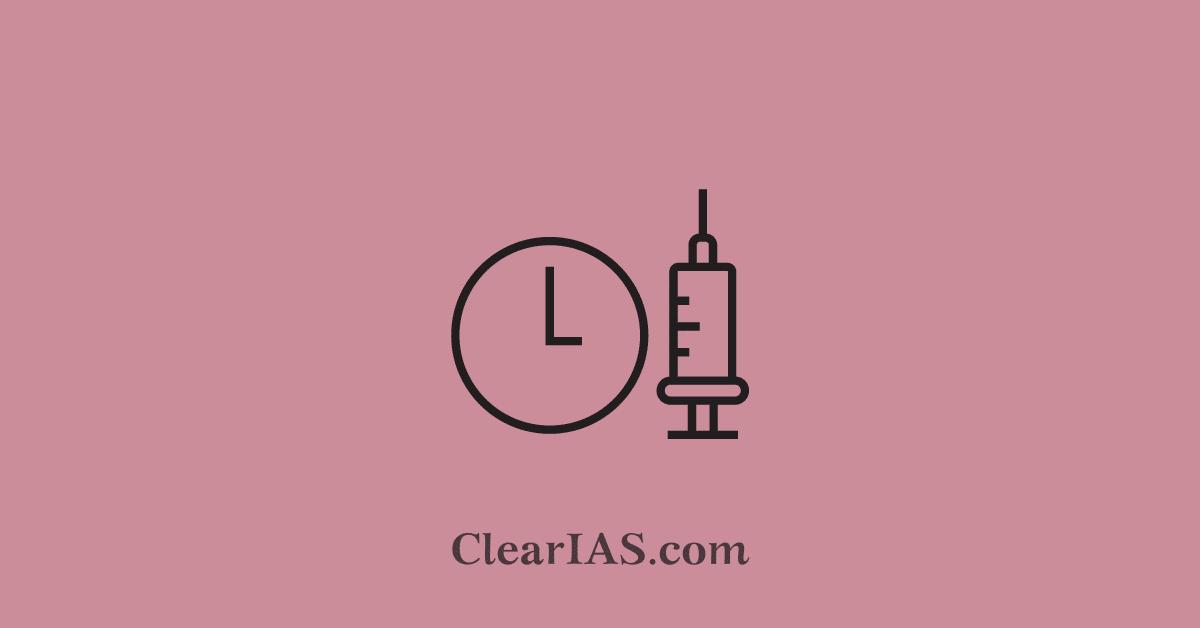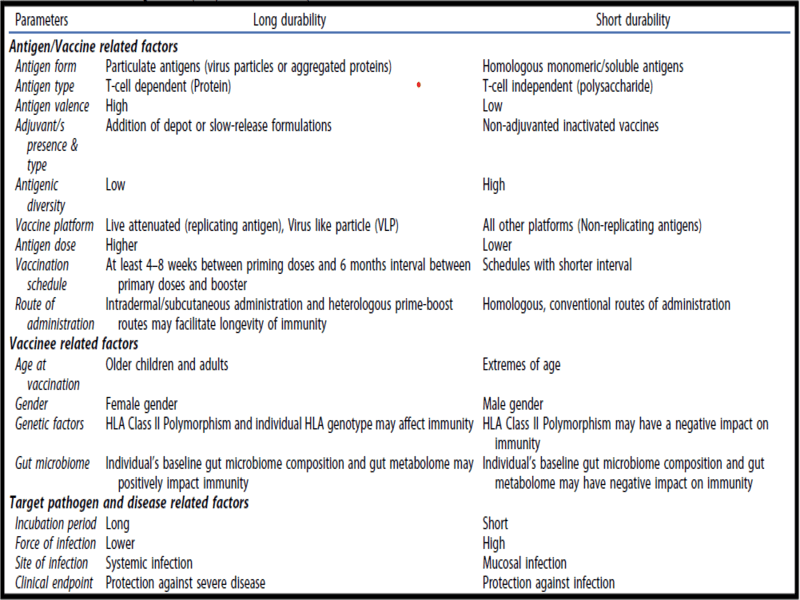
Modern vaccines are being questioned on their low durability compared to most long-term vaccines. The measles vaccine is one of the most potent vaccines in our armamentarium today. But this is not the case with most other vaccines. One needs to take several boosters for a long protection. Why is this the case? Read here to learn more.
The perceived low durability of some contemporary vaccines, particularly those developed for rapidly evolving pathogens like the influenza virus and SARS-CoV-2 (the virus responsible for COVID-19), can be attributed to several factors.
Understanding these factors requires a grasp of both the biological nature of the pathogens and the technological and immunological challenges of vaccine development.
What variables make vaccine-induced immune responses last? Can breakthroughs in these factors and technologies help us produce vaccines with better protection and fewer doses?
Read: Vaccines
Modern vaccines
Modern vaccines vary widely in both their efficacy against infection and disease and the durability of the efficacy.
- Some vaccines provide practically lifelong protection with a single dose, while others provide only limited protection following annual boosters.
- The durability of vaccine-induced protection is now a hot area in vaccinology research, especially after COVID-19 vaccines lost their lustre.
- It has fueled discussion on the eventual utility of existing vaccines to society and bolstered vaccine hesitancy.
- To sustain public trust in vaccines, lasting vaccines must be developed.
Vaccines induce immune responses that are highly complex and include orchestrated actions of a wide range of immune cells in both innate and adaptive immune systems
Vaccines that provide long duration of protection (>20 years):
- Measles vaccine
- Rubella vaccine
- Yellow fever vaccine
- Hepatitis-B vaccine
- Hepatitis-A inactivated vaccine
Vaccines that provide moderate duration of protection (5-20 years):
- Oral polio vaccine
- Inactivated poliovirus vaccine
- Hepatitis-A live attenuated vaccine
- Human papillomavirus (HPV) vaccine
- Baccile Calmette-Guerin (BCG) vaccine
- Diphtheria
- Tetanus
- Varicella zoster vaccine
- Mumps vaccine
- Pneumococcal conjugate vaccines (PCVs)
- Rabies vaccine
- Herpes zoster recombinant vaccine
- Whole-cell pertussis
- Pneumococcal polysaccharide vaccine (PPSV)
- Haemophilus influenzae type b (Hib) conjugate vaccine
Vaccines that provide a short duration of protection (<5 years):
- Meningococcal vaccines
- Acellular pertussis (aP) vaccines
- Dengue vaccines
- Cholera vaccines
- Japanese encephalitis vaccines
- Typhoid vaccines
- Herpes zoster live attenuated vaccine
- Rotavirus vaccines
- Influenza vaccines
- SARS-CoV-2 vaccines (There is no known broad estimate of the duration of protection offered by the SARS-CoV-2 vaccines against COVID-19 disease, which varies according not only to the disease state and type but also to the circulating variants.)
Factors determining the durability of protective immunity

Pathogen Evolution
- Rapid Mutation Rates: Many viruses, especially RNA viruses like influenza and SARS-CoV-2, mutate quickly. This high mutation rate can lead to the emergence of new variants that partially escape the immunity provided by existing vaccines, necessitating periodic vaccine updates or booster shots.
- Antigenic Drift and Shift: Influenza viruses undergo both antigenic drift (minor changes in virus proteins due to mutations) and antigenic shift (major changes due to the reassortment of viral genes). These processes can create new virus strains against which the population has little to no pre-existing immunity, making previous vaccines less effective.
Immune System Response
- Primary vs. Memory Response: Vaccines mimic infection, prompting the immune system to mount a response and create memory cells for future protection.
- However, the strength and longevity of the immune memory can vary based on the vaccine, the pathogen, and the individual’s immune system. Some vaccines elicit strong, long-lasting immunity, while others may provide more transient protection.
- Variability in Immune Responses: Individuals can respond differently to the same vaccine due to factors like age, genetic background, and underlying health conditions.
- For instance, older adults often have a weaker response to vaccines because of immunosenescence, the gradual deterioration of the immune system associated with ageing.
Vaccine Design and Technology
- Live Attenuated vs. Inactivated Vaccines: Live attenuated vaccines, which use a weakened form of the virus, typically offer longer-lasting immunity than inactivated vaccines, which use killed virus particles. However, live vaccines are unsuitable for all individuals, particularly those with weakened immune systems.
- Subunit, Recombinant, Polysaccharide, and Conjugate Vaccines: These vaccines use specific pieces of the pathogen (e.g., its protein, sugar, or capsid) to elicit an immune response. While they are safer and can be finely tailored to target key aspects of the pathogen, their induced immunity might not be as robust or long-lasting without boosters.
Herd Immunity and Epidemiological Factors
- Herd Immunity Thresholds: The effectiveness of a vaccine in a population also depends on reaching certain herd immunity thresholds, which vary from pathogen to pathogen. Lower vaccine durability can mean that these thresholds are harder to maintain over time without booster vaccination campaigns.
- Public Health Infrastructure and Vaccine Uptake: The distribution and administration of vaccines, along with public willingness to receive them (and booster doses as recommended), significantly impact the overall effectiveness of vaccination programs.
Why in the news?
The Hindu recently published a review of 34 currently licensed vaccines for the duration of their protective immunity.
- It was found that only five vaccines provide long-lasting protection spanning more than 20 years and only three provide lifelong protection.
- Of these 34 vaccines, 15 provide 5-20 years of protection, whereas a similar number of other shots offer short-term protection that lasts around five years or less.
How can we improve the durability of vaccine-induced protection?
Despite the vaccines’ 225-year success in controlling infectious disease, improving quality of life, increasing life expectancy, and generating substantial economic benefits, it is ironic that we are still learning how the best vaccines work and how to improve vaccine design to improve protective efficacy.
- Most of the current vaccines have been empirically developed. Vaccine durability assessment is also a ‘wait-and-see’ method due to ignorance of immunological memory mechanisms and challenges in measuring cellular components that induce long-lasting immune protection.
- Recent advancements are beginning to reduce our knowledge gaps in underlying mechanisms of vaccine-mediated protection and long-term immunity.
- We may induce more effective and long-lasting immunity with fewer dosages by exploiting these nuances and optimizing immune response linkages.
- Natural infection-induced immunity is usually more persistent than vaccine-induced protection. Exploring this disparity is one approach to developing more durable protection vaccines.
Way forward
In response to these challenges, research continues to evolve, aiming to develop vaccines that are not only rapidly deployable but also induce longer-lasting immunity.
This includes exploring novel vaccine platforms (like mRNA vaccines), adjuvants that enhance immune responses, and universal vaccines targeting conserved pathogen components to provide broad protection against multiple strains or even different viruses.
Conclusion
Understanding the durability of vaccine protection is complex and influenced by the interplay of pathogen biology, host immune responses, vaccine technology, and public health strategies.
Continuous research and surveillance are essential to adapt vaccination strategies to changing pathogen landscapes.
Related articles:
- Typbar Typhoid vaccine
- Nasal vaccine for Covid
- Global Alliance for Vaccines and Immunisation (GAVI)
- Universal Immunisation Program in India
-Article by Swathi Satish





Leave a Reply